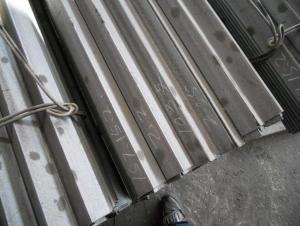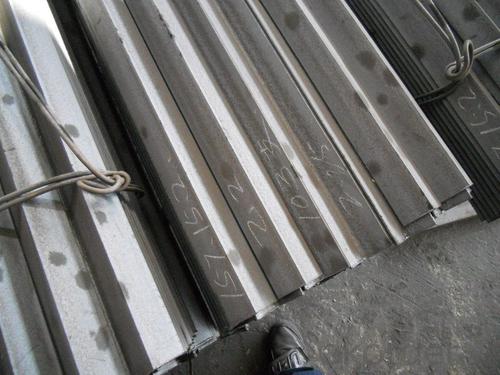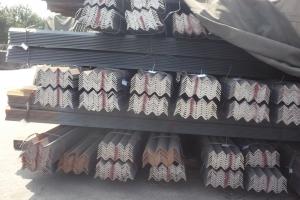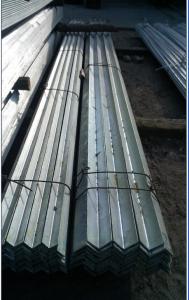Structure Steel Angle Bar Made In China Q235 JIS GB
- Loading Port:
- Tianjin
- Payment Terms:
- TT OR LC
- Min Order Qty:
- 25 m.t.
- Supply Capability:
- 40000 m.t./month
OKorder Service Pledge
OKorder Financial Service
You Might Also Like
Specification
Product Description:
OKorder is offering Structure Steel Angle Bar Made In China Q235 JIS GB at great prices with worldwide shipping. Our supplier is a world-class manufacturer of steel, with our products utilized the world over. OKorder annually supplies products to European, North American and Asian markets. We provide quotations within 24 hours of receiving an inquiry and guarantee competitive prices.
Product Applications:
Structure Steel Angle Bar Made In China Q235 JIS GB are ideal for structural applications and are widely used in the construction of buildings and bridges, and the manufacturing, petrochemical, and transportation industries.
Product Advantages:
OKorder's Structure Steel Angle Bar Made In China Q235 JIS GB are durable, strong, and resist corrosion.
Main Product Features:
· Premium quality
· Prompt delivery & seaworthy packing (30 days after receiving deposit)
· Corrosion resistance
· Can be recycled and reused
· Mill test certification
· Professional Service
· Competitive pricing
Product Specifications:
Specifications of Structure Steel Angle Bar
1.Invoicing on theoretical weight or actual weight as customer request
2.Standards:GB,ASTM,BS,AISI,DIN,JIS3.Material:GBQ235B,Q345BorEquivalent;ASTMA36;EN10025,S235JR,S355JR;JISG3192,SS400;SS540.
4.Sizes:
EQUAL ANGLES SIZES |
| ||
a(mm) | a1(mm) | thickness(mm) | length |
25 | 25 | 2.5---3.0 | 6M/12M |
30 | 30 | 2.5---4.0 | 6M/12M |
38 | 38 | 2.5 | 6M/12M |
38 | 38 | 3.0---5.0 | 6M/12M |
40 | 40 | 3.0---6.0 | 6M/12M |
50 | 50 | 3 | 6M/12M |
50 | 50 | 3.7---6.0 | 6M/9M/12M |
60 | 60 | 5.0---6.0 | 6M/9M/12M |
63 | 63 | 6.0---8.0 | 6M/9M/12M |
65 | 65 | 5.0---8.0 | 6M/9M/12M |
70 | 70 | 6.0---7.0 | 6M/9M/12M |
75 | 75 | 5.0---10.0 | 6M/9M/12M |
80 | 80 | 6.0---10.0 | 6M/9M/12M |
90 | 90 | 6.0---10.0 | 6M/9M/12M |
100 | 100 | 6.0---12.0 | 6M/9M/12M |
120 | 120 | 8.0-12.0 | 6M/9M/12M |
125 | 125 | 8.0---12.0 | 6M/9M/12M |
130 | 130 | 9.0-12.0 | 6M/9M/12M |
140 | 140 | 10.0-16.0 | 6M/9M/12M |
150 | 150 | 10---15 | 6M/9M/12M |
160 | 160 | 10---16 | 6M/9M/12M |
180 | 180 | 12---18 | 6M/9M/12M |
200 | 200 | 14---20 | 6M/9M/12M |
5. Material details:
Alloy No | Grade | Element (%) | |||||
C | Mn | S | P | Si | |||
|
|
|
|
|
|
| |
Q235 | B | 0.12—0.20 | 0.3—0.7 | ≤0.045 | ≤0.045 | ≤0.3 | |
|
|
|
|
|
|
| |
Alloy No | Grade | Yielding strength point( Mpa) | |||||
Thickness (mm) | |||||||
≤16 | >16--40 | >40--60 | >60--100 | ||||
≥ | |||||||
|
|
|
|
|
| ||
Q235 | B | 235 | 225 | 215 | 205 | ||
Alloy No | Grade | Tensile strength (Mpa) | Elongation after fracture (%) | ||||
Thickness (mm) | |||||||
| ≤16 | >16--40 | >40--60 | >60--100 | |||
≥ | |||||||
|
|
|
|
|
|
| |
Q235 | B | 375--500 | 26 | 25 | 24 | 23 | |
Usage & Applications of Structure Steel Angle Bar
According to the needs of different structures, Angle can compose to different force support component, and also can be the connections between components. It is widely used in various building structures and engineering structures such as roof beams, bridges, transmission towers, hoisting machinery and transport machinery, ships, industrial furnaces, reaction tower, container frame and warehouse etc.
FAQ:
Q1: Why buy Materials & Equipment from OKorder.com?
A1: All products offered byOKorder.com are carefully selected from China's most reliable manufacturing enterprises. Through its ISO certifications, OKorder.com adheres to the highest standards and a commitment to supply chain safety and customer satisfaction.
Q2: How do we guarantee the quality of our products?
A2: We have established an advanced quality management system which conducts strict quality tests at every step, from raw materials to the final product. At the same time, we provide extensive follow-up service assurances as required.
Q3: How soon can we receive the product after purchase?
A3: Within three days of placing an order, we will begin production. The specific shipping date is dependent upon international and government factors, but is typically 7 to 10 workdays.
Q4: What makes stainless steel stainless?
A4: Stainless steel must contain at least 10.5 % chromium. It is this element that reacts with the oxygen in the air to form a complex chrome-oxide surface layer that is invisible but strong enough to prevent further oxygen from "staining" (rusting) the surface. Higher levels of chromium and the addition of other alloying elements such as nickel and molybdenum enhance this surface layer and improve the corrosion resistance of the stainless material.
Q5: Can stainless steel rust?
A5: Stainless does not "rust" as you think of regular steel rusting with a red oxide on the surface that flakes off. If you see red rust it is probably due to some iron particles that have contaminated the surface of the stainless steel and it is these iron particles that are rusting. Look at the source of the rusting and see if you can remove it from the surface.
Images:
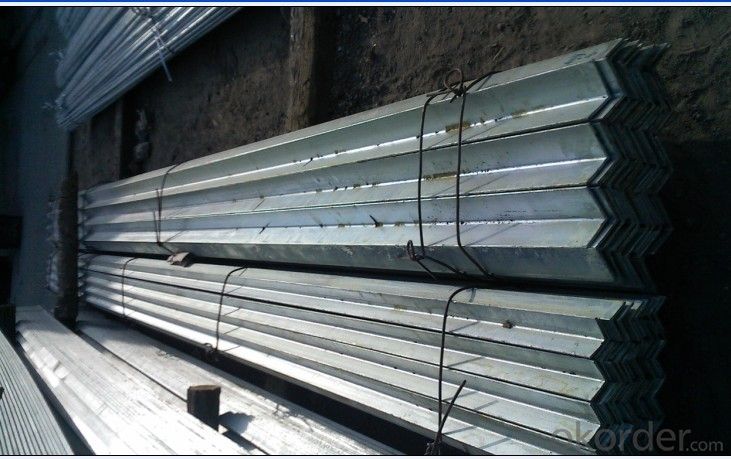

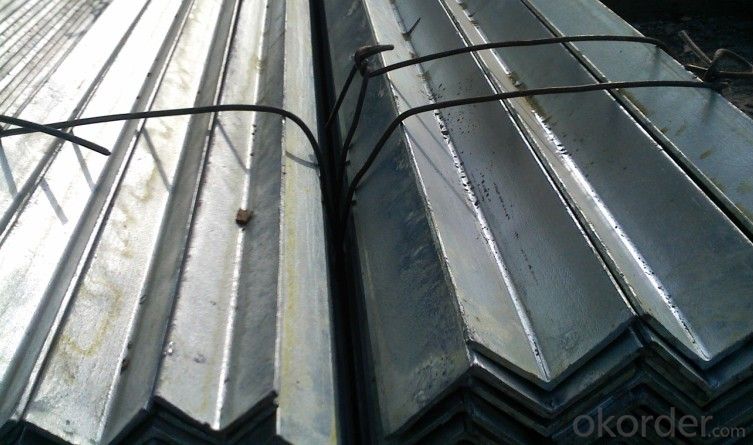
- Q: Can steel angles be used for framing or supporting exterior cladding systems?
- Steel angles have the capability to be utilized for the framing or support of exterior cladding systems. In construction, steel angles are widely employed due to their ability to provide structural support and stability. When employed for the framing or support of exterior cladding systems, steel angles deliver both durability and strength, guaranteeing the stability and longevity of the cladding. Frequently, they are employed to establish a framework or support structure for attaching cladding materials, such as siding or panels, to the outer surface of a building. The versatility of steel angles allows for easy customization and fabrication to meet specific design requirements, making them an excellent choice for framing or supporting exterior cladding systems.
- Q: What are the standard sizes of steel angles?
- The standard sizes of steel angles can vary depending on the region and industry, but there are some common sizes that are widely used. In general, steel angles come in equal leg and unequal leg sizes. For equal leg angles, the standard sizes range from 20x20mm to 200x200mm, with thicknesses ranging from 3mm to 26mm. Unequal leg angles typically have one leg longer than the other, and their standard sizes range from 25x16mm to 200x150mm, with thicknesses ranging from 3mm to 15mm. These standard sizes are commonly used in construction, engineering, and manufacturing industries for various applications, such as structural supports, framing, and bracing. It's important to note that these sizes may vary depending on the specific requirements of a project or the standards set by the governing bodies within the industry.
- Q: Can steel angles be painted or coated for aesthetic purposes?
- Steel angles can indeed be painted or coated to improve their appearance and shield them from corrosion. Typically, this entails cleaning the surface of the steel angles to eliminate any dirt, oil, or rust, followed by applying a primer and paint or a specialized coating. The selection of paint or coating will vary based on the desired aesthetic and the environmental conditions the steel angles will encounter. Through the process of painting or coating steel angles, they can be personalized to complement the surrounding decor or architectural design, resulting in a more visually attractive appearance that seamlessly harmonizes with the overall aesthetic.
- Q: What are the considerations for selecting the appropriate steel angle finish?
- Several factors need to be taken into account when choosing the right steel angle finish. Firstly, the intended use or application of the steel angle is a primary consideration. Different finishes offer varying levels of corrosion resistance, which is crucial in environments with moisture or chemicals. For outdoor applications or high humidity environments, a hot-dip galvanized finish is often preferred due to its excellent corrosion resistance. Conversely, a plain steel finish may suffice for indoor applications where corrosion resistance is not a major concern. The desired aesthetic appearance is another consideration. Steel angles can be finished in different ways to achieve various looks. A mill finish provides a raw, industrial appearance, while a powder coat finish offers a polished look and a wide range of color options. The choice of finish depends on the desired aesthetic effect and the overall project design. Durability is also an important factor to consider. Finishes like zinc plating or stainless steel offer enhanced durability and resistance to wear and tear, making them suitable for heavy-duty applications or high-traffic areas. On the other hand, a painted finish may be more prone to chipping or scratching, making it less suitable for long-term durability requirements. Lastly, cost plays a significant role in the decision-making process. Different finishes have varying costs associated with them, so it is necessary to balance the desired finish with the available budget. It is worth noting that while certain finishes may have a higher upfront cost, they may provide long-term cost savings by reducing maintenance or replacement needs. To summarize, the appropriate steel angle finish selection depends on factors such as corrosion resistance, aesthetic appearance, durability requirements, and budget considerations. By carefully evaluating these factors, one can choose the most suitable finish that meets both functional and aesthetic needs.
- Q: How do steel angles compare to wooden beams?
- Steel angles are often preferred over wooden beams due to their superior strength and durability. Steel angles have a higher load-bearing capacity, making them suitable for supporting heavier structures. They are also fire-resistant and less susceptible to warping, rotting, or termite infestation, which are common issues with wooden beams. Additionally, steel angles are more versatile as they can be easily customized and shaped to fit specific construction requirements.
- Q: What is the maximum span for a steel angle?
- Various factors, including the size, shape, and thickness of a steel angle, as well as the load it is anticipated to bear, determine its maximum span. Typically, greater maximum spans are achievable with larger and thicker steel angles. Nonetheless, it is crucial to refer to structural engineering standards, codes, and consult with professional engineers to ascertain the specific maximum span for a particular steel angle in a specific application. These specialists will take into account factors like the material's yield strength, deflection limits, and safety factors to offer precise guidelines for the maximum span.
- Q: Are steel angles available in different alloys?
- Different alloys are available for steel angles, providing a wide range of options. Typically, steel angles are made from carbon steel, which is a versatile and common type of steel. However, specific applications may call for other alloys. For instance, stainless steel angles are made from an alloy containing chromium, offering increased resistance to corrosion. In addition, high-strength low-alloy (HSLA) steel angles combine carbon steel with small amounts of elements like manganese, phosphorus, or sulfur to enhance strength and durability. This variety of alloys allows for a diverse range of applications and properties to meet specific needs across various industries.
- Q: Can steel angles be cold-formed or bent to specific shapes?
- Yes, steel angles can be cold-formed or bent to specific shapes. Cold forming is the process of reshaping a metal without the use of heat, typically through methods such as bending, rolling, or pressing. Steel angles, which are L-shaped structural components made of steel, can be cold-formed to achieve various shapes and angles as per the specific requirements of a project. This process involves applying force and pressure to the steel angle, causing it to deform and take on the desired shape. Cold forming steel angles allows for flexibility in design and customization while maintaining the strength and durability of the steel.
- Q: What is the minimum bend radius for a steel angle?
- The minimum bend radius for a steel angle depends on the specific dimensions and thickness of the angle. It is generally recommended to consult the manufacturer or reference industry standards to determine the appropriate minimum bend radius for a particular steel angle.
- Q: How do steel angles contribute to sustainable construction?
- Steel angles contribute to sustainable construction in several ways: 1. Durability: Steel angles are made of a highly durable material that can withstand extreme weather conditions and have a long lifespan. This reduces the need for frequent repairs or replacements, minimizing waste and resources. 2. Recyclability: Steel angles are 100% recyclable, meaning that at the end of their life cycle, they can be melted down and reused to make new steel products. This reduces the demand for virgin steel production, which is energy-intensive and contributes to greenhouse gas emissions. 3. Structural efficiency: Steel angles provide excellent structural support, allowing for the creation of lighter and more efficient building designs. This reduces the amount of material needed for construction, minimizing the overall environmental impact. 4. Energy efficiency: Steel angles can be easily integrated into energy-efficient building systems. They are often used in the construction of sustainable buildings, such as green roofs, solar panel installations, and energy-efficient facades, which help reduce energy consumption and promote a greener environment. Overall, steel angles contribute to sustainable construction by offering durability, recyclability, structural efficiency, and energy efficiency, making them an environmentally friendly choice for builders and architects.
Send your message to us
Structure Steel Angle Bar Made In China Q235 JIS GB
- Loading Port:
- Tianjin
- Payment Terms:
- TT OR LC
- Min Order Qty:
- 25 m.t.
- Supply Capability:
- 40000 m.t./month
OKorder Service Pledge
OKorder Financial Service
Similar products
Hot products
Hot Searches
Related keywords
